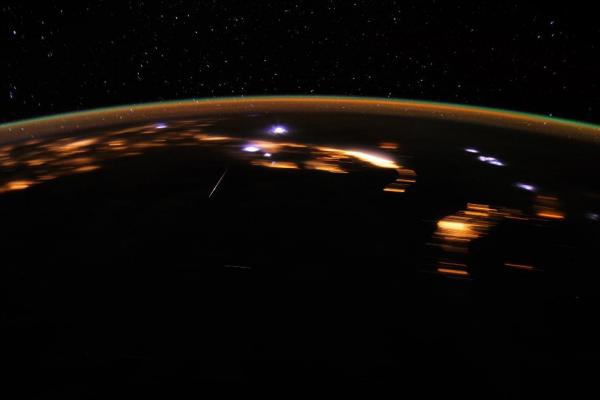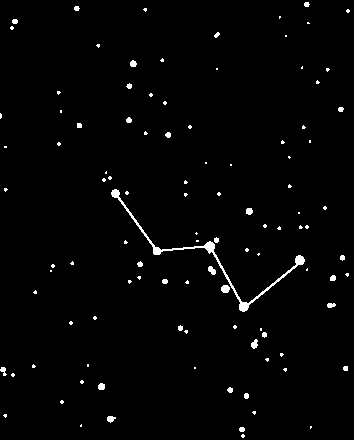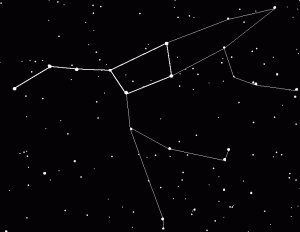Archive for the ‘Meteors’ Category
The Geminids 2014
Over the weekend was the peak of the annual Geminid Meteor Shower. This year, it was actually clear skies over our house meaning the sky was perfectly clear. In fact, it was the best clear sky that we have had for a very long time! There was no moon and the stars and constellations were twinkling beautifully in the night sky. Of course, being this time of year, it meant the clear sky made the temperature absolutely freezing! In fact, it was minus 1.2 by 22:30 so we were quite chilly stood outside!
My wife and I went out to look on two occasions in the evening. The first viewing lasted for about 45 minutes, starting at about 19:45 on Saturday. I was out on my own at first but didn’t see any meteors until my wife made an appearance, which was about 20 minutes in to the viewing. I did have a great time using my camera to try and take photos of the constellation Cassiopeia and the Pleiades but unfortunately my lens wasn’t big enough, so all I took was darkness. It took me a few minutes to get my bearings on where the meteors would originate from, but found that it was directly behind our house. This meant we could stand on the back step and be looking in the correct direction. The only problem with this was that there is a big house directly behind ours, which blocks out the sky. This meant that we had to look directly up, which gave me neck ache the next day!
Anyway, the first viewing picked up and we eventually saw about 8 meteors. Some were very small flashes in the Sky, whilst others zoomed along and left a nice long tail behind. It was great, but we eventually got so cold that we had to go in and have a hot chocolate to drink!
We went back outside at about 10pm for about 30 minutes, by which time the rate of meteors passing by must have picked up as we were treated to some really good ones that shot across the sky and had some amazing tails. The origin of the meteors had passed to the side of the house behind us as well, so we had a clearer view of Gemini by then. I have to say that the constellation Orion looked excellent and very bright as well, which was to the south east of Gemini. At one point we must have seen about 3 big meteors in the space of about 15 seconds, and they were all over the sky. It was great! But, as mentioned above, the temperature had reached sub zero levels by now, and we were just too cold, so we called it a night. In this time we saw about 10 really good meteors, which was very pleasing.
The Geminid Meteor Shower of 2014 was probably the best one that we have seen from our house in Plymouth. The moon was down, the sky was dark and the starts shone so brightly. It was an amazing sight, and to see lots of meteors as well topped it of brilliantly! Here’s hoping for more nights like this when future meteor showers are due! 😉
Lyrids Meteor Shower 2014
For the Lyrids Meteor Shower this year, the Moon is going to keep the sky quite light, which will make it much harder to see them. Saying that, it should still be possible, especially when they are at their peak on the 23rd April. I say this as I happened to be outside this past Tuesday night, watching the ISS fly over Plymouth, and to my surprise, whilst it was moving through Ursa Major (specifically the Plough part of the constellation), there were 5 or 6 tiny little explosions going off in the sky nearby. I couldn’t quite believe it really and it put me off watching the ISS (which I always find fascinating!).
I watched for several more minutes and saw several other meteors in the sky, in the general area of the sky off to the left of Ursa Major. These were not massive meteors as far as I could tell, as you only saw them for a split second, but this was probably due to the almost full moon which was keeping the sky bright and hiding all but the most brightest stars. These weren’t like the tiny explosions I saw during the ISS flyover, but more meteor like. I can only presume these were the Lyrids and the first batch I saw were so small and didn’t ‘shoot across the sky’ but burnt up as soon as they hit the atmosphere of the Earth. The second batch must have been slightly bigger and lasted longer when hitting the atmosphere. Either way, it was great viewing!
The Lyrids Meteors emanate from the constellation Lyra (hence their name) and they are part of the comet Thatcher that takes about 415 years to orbit the Sun. The peak of the shower is usually around the 21st to the 24th of April but they can be seen for several days before and after, depending on how lucky you are! I guess I was very lucky the other night!
Enjoy the Lyrids Meteor Gazing!! 😉
Perseids 2013
Last night I spent about 40 minutes outside meteor spotting. Luckily it was the first night in ages that there was a mostly clear sky, apart from the occasional wispy clouds that passed overhead. It was good timing as last night was the peak of the Perseid Meteor shower of 2013 although you can still see meteors up until the 24th August when the Earth passes out of the meteor hot spot.
It took a while to spot anything but in the end I managed to see 8 meteors, 4 satellites, the International Space Station (ISS – which was a nice surprise!) and a strange looking triangle shaped Plane with weird flashing lights (aliens? 😉 ). The most interesting thing of all was that I also saw a bright flash in the sky and then it gradually faded away. I think it must have been a larger meteor hitting the atmosphere and exploding or something but it seemed to be heading in the wrong direction for the meteor shower, which made it more strange. It would be interesting to know if anyone else saw this last night? It must have been about 23:20 when I saw this. Please leave a comment on this post if you did see that last night as well!
As mentioned above, if you missed the meteor show last night, then you can still see them up until near the end of the month. If you can find the constellations of Cassiopeia and The Plough (Ursa Major), then kind of look between and above them and this is the general area where the meteors shoot across the sky. There were some really good ones and a couple of years ago I saw the best meteor I have ever seen towards the end of August, so it is definitely possible to see them for a few weeks yet!
Eta Aquarids Meteor Shower 2013
For those of you who are very early risers in the morning, the Eta Aquarids Meteor Shower is for you! Unfortunately, for those of us who can’t get up in the morning we will probably miss this shower, as the best time to view these meteors is in the couple of hours before dawn. This is when the radiant of the meteor shower comes over our horizion in the Northern Hemisphere.
The good thing about this meteor shower is that you can see the meteors several days before the peak, which is on May 5th, and then for several days after. I believe the full timescale is from the 19th April until the 28th May, so they can be seen for over a month, if you are willing to get up in the morning! The number of meteors that should be seen each hour could peak at about 70 per hour if you are lucky, but you are more likely to see around 10-20 per hour in the Northern Hemisphere, with each meteor travelling at approx 66km/s. This year is actually a very good year to view the Eta Aquarids as the moon is only a waning crescent so will not make the sky too bright.
This meteor shower is called the Eta Aquarids as the radiant of the shower looks to emanate from the star Eta in the constellation of Aquarius. Aquarius is also known as the ‘Water Bearer’ and is shown in the image below. The meteors from this shower are actually dust and debris left behind from Halleys Comet, with this shower coming about due to the Earth passing through this orbital path of the Comet and thus ploughing straight through the path of debris
Lyrid Meteor Shower 2013
Unfortunately, this year the viewing of the Lyrid meteor shower will be hindered by a very bright and almost full Moon (if you get clear skies that is)! It’s a real shame as the Lyrid meteor shower is one of the best ones of the year. Having said that, if you are out on its peak, which is today (the 22nd April), you may still spot the brighter meteors, but obviously these will be far fewer than if it was a clear sky as you would see the fainter ones as well.
My wife and I went out last Friday evening (19th) to try and have a look as it was a very clear sky and the Moon wasn’t quite as bright as it would be tonight, and I managed to see one very faint meteor (I think) in the distance, but that was about it. We gave up on the meteors after about half an hour as it was still just too bright and the direction they come in is close to the horizon for us where a lot of trees are situated. If it clears up again tonight, I will go out and try and view them again (with my fingers crossed!).
One good thing that came out of viewing last Friday, was that I saw 2 satellites and also the International Space Station fly over (the first time for both this year due to the constant bad weather we have had!). I always enjoy viewing the ISS, even though you don’t really see much, as it still amazes me that that is a space station which we can see shining bright from Earth. I would be happy to view it every night if I could! 😉
Anyway, happy meteor spotting tonight and leave a comment on here or my twitter account (@strethewey) if you do manage to see anything!



